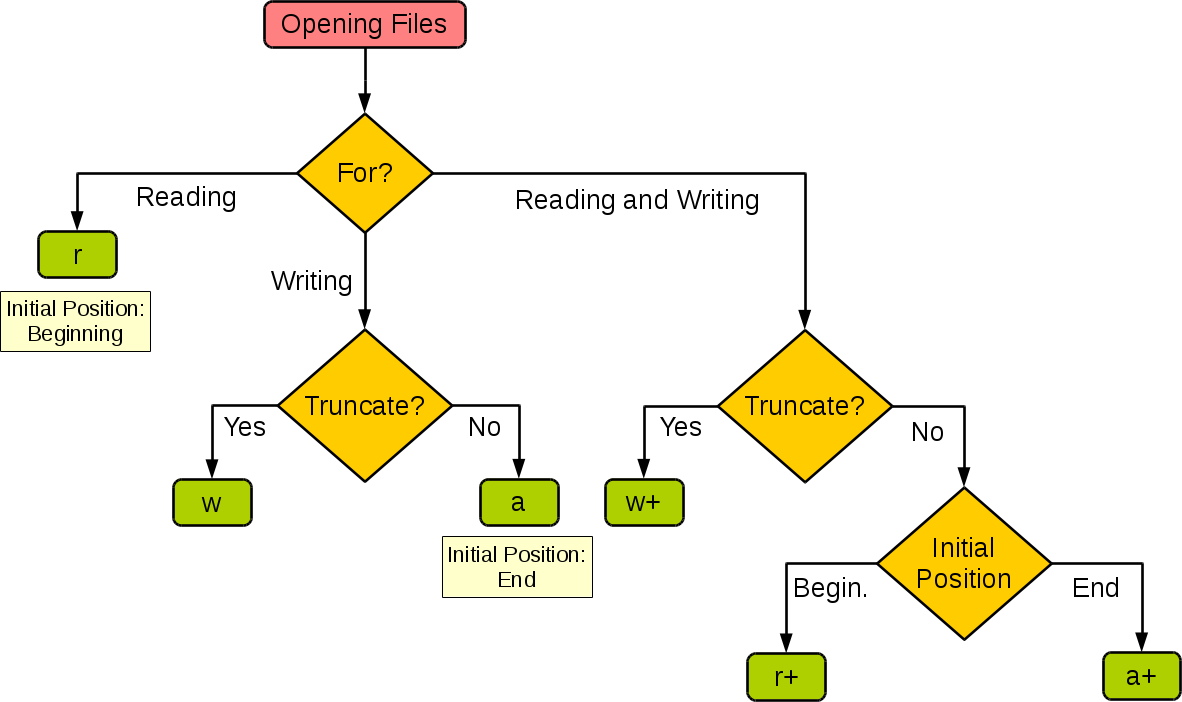Difference between modes a, a+, w, w+, and r+ in built-in open function?
In the python built-in open function, what is the exact difference between the modes w, a, w+, a+, and r+?
In particular, the documentation implies that all of these will allow writing to the file, and says that it opens the files for "appending", "writing", and "updating" specifically, but does not define what these terms mean.
The opening modes are exactly the same as those for the C standard library function fopen().
The BSD fopen manpage defines them as follows:
The argument mode points to a string beginning with one of the following
sequences (Additional characters may follow these sequences.):
``r'' Open text file for reading. The stream is positioned at the
beginning of the file.
``r+'' Open for reading and writing. The stream is positioned at the
beginning of the file.
``w'' Truncate file to zero length or create text file for writing.
The stream is positioned at the beginning of the file.
``w+'' Open for reading and writing. The file is created if it does not
exist, otherwise it is truncated. The stream is positioned at
the beginning of the file.
``a'' Open for writing. The file is created if it does not exist. The
stream is positioned at the end of the file. Subsequent writes
to the file will always end up at the then current end of file,
irrespective of any intervening fseek(3) or similar.
``a+'' Open for reading and writing. The file is created if it does not
exist. The stream is positioned at the end of the file. Subse-
quent writes to the file will always end up at the then current
end of file, irrespective of any intervening fseek(3) or similar.
I noticed that every now and then I need to Google fopen all over again, just to build a mental image of what the primary differences between the modes are. So, I thought a diagram will be faster to read next time. Maybe someone else will find that helpful too.

Same info, just in table form
| r r+ w w+ a a+
------------------|--------------------------
read | + + + +
write | + + + + +
write after seek | + + +
create | + + + +
truncate | + +
position at start | + + + +
position at end | + +
where meanings are: (just to avoid any misinterpretation)
- read - reading from file is allowed
write - writing to file is allowed
create - file is created if it does not exist yet
trunctate - during opening of the file it is made empty (all content of the file is erased)
position at start - after file is opened, initial position is set to the start of the file
- position at end - after file is opened, initial position is set to the end of the file
Note: a and a+ always append to the end of file - ignores any seek movements.
BTW. interesting behavior at least on my win7 / python2.7, for new file opened in a+ mode:write('aa'); seek(0, 0); read(1); write('b') - second write is ignoredwrite('aa'); seek(0, 0); read(2); write('b') - second write raises IOError
The options are the same as for the fopen function in the C standard library:
w truncates the file, overwriting whatever was already there
a appends to the file, adding onto whatever was already there
w+ opens for reading and writing, truncating the file but also allowing you to read back what's been written to the file
a+ opens for appending and reading, allowing you both to append to the file and also read its contents